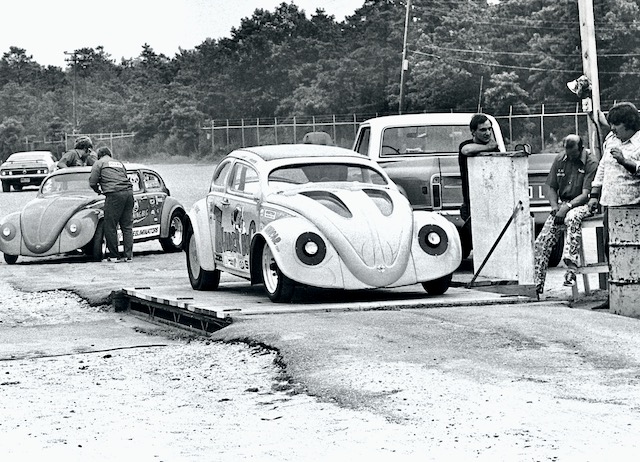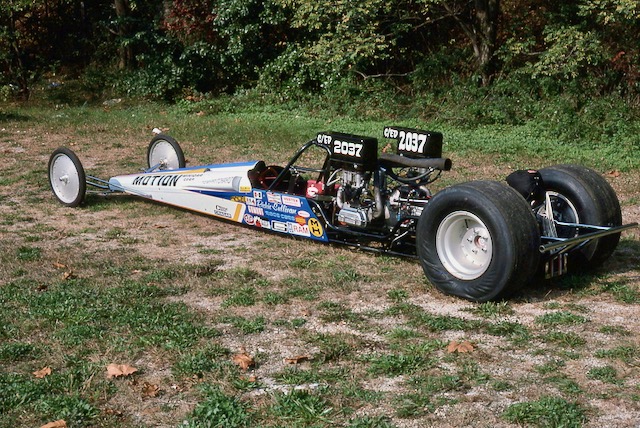After setting records for two years in Baldwin-Motion’s A/MP Camaro, in 1970 Bill Mitchell shrinks the Supercar and continues his winning ways driving the MOTION MINICAR VW THUNDERBUG.
 New model introductions for 1970 reinforced Detroit’s accelerating love affair with performance. It was a new decade and carmakers continued seducing buyers with the most powerful Ponycars and Supercars yet. It was a boom year for Motown Muscle. And it was a record year for Baldwin-Motion and Motion Performance.
New model introductions for 1970 reinforced Detroit’s accelerating love affair with performance. It was a new decade and carmakers continued seducing buyers with the most powerful Ponycars and Supercars yet. It was a boom year for Motown Muscle. And it was a record year for Baldwin-Motion and Motion Performance.
However, Joel Rosen had serious doubts about how long the horsepower wars would continue. By 1970 he had already established lines of communication with engineers at Chevrolet and Oldsmobile and he was getting mixed messages regarding the future of industry involvement with performance. While some engineers were optimistic about higher-output engines and racing packages, others forecasted a dim future. Some predicted that environmental and safety issues would sound the death knell for performance cars. They ended up being the true visionaries!
Concerned about the future, Rosen evaluated alternatives, eventually focusing on specialty vehicles powered by hot-rodded VW engines.“I felt strongly that we could apply our proven Motion branding and marketing philosophy to more affordable VW-powered vehicles,” said Rosen. It was a significant leap of faith for the man who believed that there really was no substitute for cubic inches. He would learn that less could actually be more!

 Rosen partnered with Bill Mitchell and me in 1970, opening Motion Minicar adjacent to Motion Performance. It would remain an integral part of the Motion complex until 1975 when business slowed and Mitchell left to spend more time racing.
Rosen partnered with Bill Mitchell and me in 1970, opening Motion Minicar adjacent to Motion Performance. It would remain an integral part of the Motion complex until 1975 when business slowed and Mitchell left to spend more time racing.
Following the successful Motion business model, Mitchell installed an engine dyno and built high-performance street VWs, dune buggies, and record-shattering racecars. I worked with Mitchell and Rosen to create the Thunderbug and Motion Minicar brands and the programs to market them. Mitchell developed a potent line of Phase III VW engines – from an 85-horsepower, 1.4-Liter daily driver to a 150-horsepower, 2.2-Liter Street Eliminator with 48-mm Webers.
Between Mitchell’s unstoppable MOTION MINICAR VW THUNDERBUG and Porsche-bodied racecars that dominated H/Gas competition from 1971 to 1973 and customized high-performance dune buggies, Motion Minicar became a major player in the emerging hot VW field. In late 1971 Motion Minicar dune buggies and a Phase III VW Thunderbug were featured on New York’s WNEW TV-5 Evening News. Popular TV sportscaster Lee Leonard put Minicar’s hottest vehicles to the test on Brooklyn’s Brighton Beach.
 That TV spot led to the prestigious placement of Minicar dune buggies in the Owens-Corning Fiberglas Showroom on Fifth Avenue and 56th Street in New York City. The exhibit showcased creative applications of fiberglass-reinforced plastics. A diplomat from Haiti’s embassy happened to photograph the Minicar display. This started a chain of events that eventually lead to the building a dune buggy for Haiti’s notorious Francois “Papa Doc” Duvalier. Papa Doc ordered it as a surprise birthday present for his son, Jean-Claude, better known as “Baby Doc.”
That TV spot led to the prestigious placement of Minicar dune buggies in the Owens-Corning Fiberglas Showroom on Fifth Avenue and 56th Street in New York City. The exhibit showcased creative applications of fiberglass-reinforced plastics. A diplomat from Haiti’s embassy happened to photograph the Minicar display. This started a chain of events that eventually lead to the building a dune buggy for Haiti’s notorious Francois “Papa Doc” Duvalier. Papa Doc ordered it as a surprise birthday present for his son, Jean-Claude, better known as “Baby Doc.”
“When completed, I put the Metalflake buggy on our racecar trailer and delivered it to the Gramercy Park Hotel in New York City where Baby Doc was celebrating his birthday. We gift-wrapped it with huge ribbons in front of the hotel and gave the keys to Haitian security officers. After the party it was crated and put on a freighter bound for Haiti,” said Mitchell.
 It was the radically chopped, record-setting, VW-bodied MOTION MINICAR VW THUNDERBUG that catapulted Motion Minicar into the national limelight in 1972. A fiberglass-bodied, tube-frame H/Gas racecar, it replaced Minicar’s earlier 1970 Thunderbug that had a stock-height body. Sitting just 47 inches off the ground, the new Thunderbug’s body was secured to tubular steel rails with Dzus fasteners and could be completely removed in minutes. Its nose and primary body assembly tilted for suspension and engine access.
It was the radically chopped, record-setting, VW-bodied MOTION MINICAR VW THUNDERBUG that catapulted Motion Minicar into the national limelight in 1972. A fiberglass-bodied, tube-frame H/Gas racecar, it replaced Minicar’s earlier 1970 Thunderbug that had a stock-height body. Sitting just 47 inches off the ground, the new Thunderbug’s body was secured to tubular steel rails with Dzus fasteners and could be completely removed in minutes. Its nose and primary body assembly tilted for suspension and engine access.
 Power for the Gasser came from a 245 horsepower (at 7,300 rpm), Mitchell-built 2,180-cc motor. The 13.7-to-l “hand grenade” motor was fitted with Scat 82-mm forged steel crank, 92-mm forged aluminum pistons on Porsche rods, .500-inch-lift Thunderbug cam, ported and polished dual-port Thunderbug heads with 42-mm intake and 35.5-mm exhaust valves, a pair of 48 IDA Webers and a Vertex magneto. A close-ratio four-speed Porsche transaxle with 4.44 gears and ZF “locker” completed the powertrain. It was available as a crate engine for customers.
Power for the Gasser came from a 245 horsepower (at 7,300 rpm), Mitchell-built 2,180-cc motor. The 13.7-to-l “hand grenade” motor was fitted with Scat 82-mm forged steel crank, 92-mm forged aluminum pistons on Porsche rods, .500-inch-lift Thunderbug cam, ported and polished dual-port Thunderbug heads with 42-mm intake and 35.5-mm exhaust valves, a pair of 48 IDA Webers and a Vertex magneto. A close-ratio four-speed Porsche transaxle with 4.44 gears and ZF “locker” completed the powertrain. It was available as a crate engine for customers.
Mitchell started setting records with the chopped yellow MOTION MINICAR VW THUNDERBUG almost immediately after sorting it out. On April 29, 1972, he ran 116.88 mph in 11.09 seconds against an 11.51 record at the NHRA Division 2 Points Meet at Suffolk Raceway in Virginia. During the Eliminations, Mitchell posted unbelievable 11.04s-11.06s. During that weekend in Virginia, Bill Mitchell nailed a total of 16 IHRA and NHRA National Records! He set four ET and four MPH records, running in G, I, J and K/Gas at the IHRA Nationals on Saturday at Colonial Beach. The next day at the NHRA meet at Suffolk Raceway, Mitchell collected eight more records!

 At the NHRA Points Meet at Suffolk, Motion ruled the day. Mitchell took the H/Gas win in the Thunderbug and Dennis Ferrara, driving the Baldwin-Motion big-block Camaro, won A/Modified Production. Both cars set records and ended up running against each other for Eliminator. Cubic inches ruled and the Camaro took the gold.
At the NHRA Points Meet at Suffolk, Motion ruled the day. Mitchell took the H/Gas win in the Thunderbug and Dennis Ferrara, driving the Baldwin-Motion big-block Camaro, won A/Modified Production. Both cars set records and ended up running against each other for Eliminator. Cubic inches ruled and the Camaro took the gold.
Bill Mitchell continued his winning ways, “owning” the NHRA H/Gas record in 1972 and 1973. In late 1973 Mitchell built a chopped 911 Porsche to replace the yellow Thunderbug. The Porsche, fitted with a fiberglass body and carryover Thunderbug race engine, sat on a Richie Sullivan chassis. The folks at NHRA were not happy when Mitchell started running the new car. It obliterated existing records, running consistent 10.20s. It was too quick, prompting NHRA to change the rules. Mitchell didn’t want to play NHRA’s game and retired the “slammed” Porsche.
 By 1975 the hot VW business had run its course and Mitchell wanted to spend more time racing. In the spring of 1975, we closed Minicar’s doors. Mitchell continued to drive racecars for five years and then moved on to launch Bill Mitchell HARDCORE Racing Products and World Products.
By 1975 the hot VW business had run its course and Mitchell wanted to spend more time racing. In the spring of 1975, we closed Minicar’s doors. Mitchell continued to drive racecars for five years and then moved on to launch Bill Mitchell HARDCORE Racing Products and World Products.
For the full story on the MOTION MINICAR VW THUNDERBUG, Motion and Baldwin-Motion, check out https://www.amazon.com/Motion-Performance-Tales-Muscle-Builder/dp/0760355606/ref=sr_1_1?s=books&ie=UTF8&qid=1493151743&sr=1-1&keywords=MOTION+Performance%2C+Tales+of+a+muscle+car+builder

